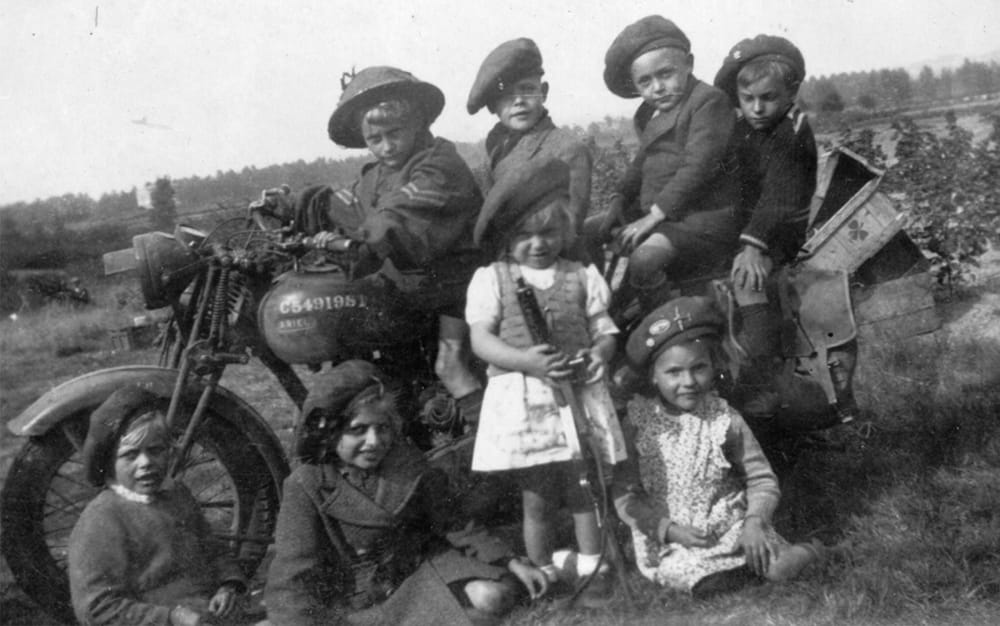Hello from the US.
The issue:
I wrote in a while ago complaining of a loud knocking in the top end of my 1943 M20, after warming up. Starts up OK, runs for a while, then starts to knock in the top end, then stalls. Will do this static in the garage, or on the street. Give it a minute after the stall, and it will start up again OK, runs OK again for a few minutes, then knocking and stall.
Upon publication of this issue in this forum, I was the glad recipient of numerous suggestions of what might be the problem. I spent a lot of time trying out potential solutions without having to disassemble the top end. Most helpful was a trial of many spark plug heats and gasoline (petrol) variants.
Finally I ran out of easy fixes, and took off the head and barrel. The piston was slightly scuffed on the skirt, but most importantly, the worst scuff marks were 180 degrees apart. Apparently the piston was expanding from the heat and created an interference fit with the cylinder wall. I am frugal by nature so my last top end rebuild I did not have the cylinder re-bored. My mistake, because the new +.040 piston at that time was not a perfect match with the cylinder bore. The slightly used, but serviceable piston set is now for sale on Ebay.
Subsequently, I had the cylinder bored to +.060, fitted a new oversize piston, wrist pin, had the valve seats and valves machined and fitted a new connecting rod small bush. I have so far run the moto in the garage at various RPMs for over an hour (with cooling fan) with no knocking. If the weather cooperates this week, some short runs on the local neighborhood streets.
I would like to thank everyone for their valued suggestions, some of which I had already tested, some not.
Stewardship of a vintage motorcycle is always a learning experience. And now it runs soooooo good.....
Regards
Dave W.
WA state USA.
email (option): dwdiak4@gmail.com
Hi Dave. The piston skirt at it's widest part should have a clearance in the new bore of 3.5 to 5 thousandths of an inch, which is sometimes not aware of by engineers who normally work on modern engines.....These old side valves run quite hot. Which is also why they should be run at the correct full ignition advance.......Retarded ignition and or a weak petrol mixture will also cause the engine to run hotter. Ron
email (option): ronpier@talk21.com
Glad to hear you seem to have identified the problem...My advice would be never to assume that because something is new any specified clearance will be correct...
These days CNC machines can consistently produce very tight tolerances, in fact current machines will detect slight variations from the required dimension and self adjust to rectify them...
In the past machine tools (and their operators) were not able to maintain that level of accuracy over a batch of parts and variations occurred within the laid down tolerances...EVERY dimension had an upper and lower tolerance applied...Non critical dimensions were indicated by a fractional dimension on the engineering drawing (e.g. 1/64th.) and the accepted standard tolerance in that case was + or - .015" from the declared dimension...
More important tolerances were specified individually in thousandths (or less) of an inch (e.g. + or - .005" or + or -.0005") around the declared dimension...
The tighter the tolerance the more difficult it was to achieve it consistently and consequently the greater the number of parts that fell outside that tolerance..This meant a higher percentage of scrap...Inspection levels also rose from a 'first and last off' which meant a check only on the first and last part made in a batch for non critical dimensions through increments up to a 100% checking rate on critical parts with very tight dimensional tolerances...In many cases additional machining operations such as finish grinding were also required to achieve the higher levels of accuracy...
Tighter tolerances therefore increased costs and it was stressed to me during my training doing production drawings in the early 70's not to 'over tolerance' components beyond what was required for function...
These conditions meant machine shops were routinely producing components that had, within limits, dimensional variations. During inspection 'component selection' was frequently employed when needed to match parts over the tolerance range and to thus ensure the best dimensional compatibility...
So, when using NOS parts it is not always the case that a good fit will be achieved and a check prior to fitting is the best course...One particular example of this in the M20 engine is timing gears...I have built a number of engines using all NOS timing side components but more than once have had the situation where the mesh clearance between the gears was insufficient ...Ian
email (option): ian@wright52.plus.com
Ian:
Thanks for the information.
IMO the issue was not with the old (+.040") or new (+.060") piston O.D. dimensions. I measured these prior to assembly and were within +/- 0.0005" of the advertised diameter before top end assembly, in other words, within the accuracy of my measuring tools. I measured with both a micrometer and dial vernier caliper with the same results.
Because the old piston skirt showed scuff marks 180 degrees apart, I conclude that the cylinder bore before the most recent re-bore was oval, at least locally, and not enough clearance piston wall - to - cylinder existed at operating temperature, but adequate when running just after a cold startup. Hence the piston would bind after warming up to operating temperature and knock / stall.
The re-bore was machined out at a 0.004" clearance gap between the new +.060" piston and cylinder wall. Everything seems OK now.
D. Wadiak
email (option): dwdiak4@gmail.com
